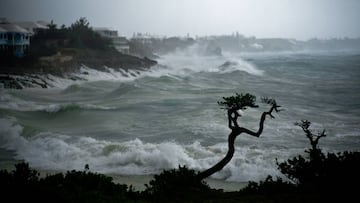Tropical Storm Beta: why is the Greek alphabet used to name hurricanes?
Tropical Storm Beta has started to lash the Texas coast this week, but why has it not been given a regular name?

Arthur, Bertha, Cristobal, Dolly… the list goes on, but there are a limited number of letters in the alphabet. What happens when there are too many storms in one year? And why do we need to name them at all?
Beta lashes the Texan coast
According to CNN weather, Beta has already begun bringing tropical storm conditions to parts of the southwestern Louisiana coast. A warning is also in effect from Port Aransas, Texas to the Rockefeller Wildlife Refuge in Louisiana, where 2 to 4 feet of storm surge is possible.
Louisiana Gov. John Bel Edwards urged residents to get ready for the storm. "Prepare for heavy rainfall and the threat of storm surge and flooding in certain regions of the state due to Tropical Storm Beta," Edwards said in a series of tweets Sunday.
I urge everyone to prepare for heavy rainfall and the threat of storm surge and flooding in certain regions of the state due to Tropical Storm Beta. https://t.co/cdZQBbVEux #lagov #Beta #lawx
— John Bel Edwards (@LouisianaGov) September 20, 2020
The National Hurricane Center has advised that anyone located within the affected regions "should take all necessary actions to protect life and property from rising water and the potential for other dangerous conditions."
A limited list of storm names every year
The World Meteorological Organization (the body responsible for naming tropical storms in the US) has a pre-prepared list each year of 21 potential storm names, listed from A to W. There are no names corresponding to Q, U, X, Y or Z because of availability.
In 2020, the WMO have come up against an unusual problem: they’ve run out of storm names. Instead they have turned to the Greek alphabet so the storm hitting Texas and Louisiana this week is called Beta, rather than a 'regular' name. The only other time this has happened before was 15 years ago in 2005, when six letters of the Greek alphabet had to be used: Tropical Storm Alpha, Hurricane Beta, Tropical Storm Gamma, Topical Storm Delta, Hurricane Epsilon and Tropical Storm Zeta
One major difference this year is that in 2005, the first letter of the Greek alphabet ‘Alpha’ was called upon on 22 October ; whereas in 2020, closely following Wilfred, Alpha formed over a month earlier on 18 September. With the hurricane season running through into November, there is a high chance 2020 will break the record and need to go to Eta, the seventh letter of the Greek alphabet, and beyond.
2005 was the most active hurricane season in the Atlantic, with 27 storms recorded. That season's most devastating, Katrina, struck Florida, Louisiana, then Mississippi at the end of August and killed 1,833 people and caused $125 billion of damage, making it the costliest natural disaster in US history.
How does the naming of tropical storms work?
According to the National Hurricane Center, for Atlantic hurricanes there is a list of names for each of 6 years, or in other words, every seventh year one list is repeated. The only time that there is a change in a name on one of these lists is if a storm turns out to be so deadly or costly that its use on a future storm would be insensitive. These names are ‘retired’ and replaced in time for the next round.
Why do we name storms?
The NHC explains that giving storms short, distinctive names is quicker and less confusing than the older method of using latitude-longitude coordinates. ‘These advantages are especially important in exchanging detailed storm information between hundreds of widely scattered stations, coastal bases, and ships at sea.’
Related stories
The United States began using female names for storms in 1953, before which a now-extinct phonetic alphabet was used. It wasn’t until 1978 when men’s names were introduced to the list as well. Perhaps it was considered a little sexist…
Nowadays, each of the 6 lists alternate between male and female names; one year starting with Arlene, the next with Alberto, and so on.
